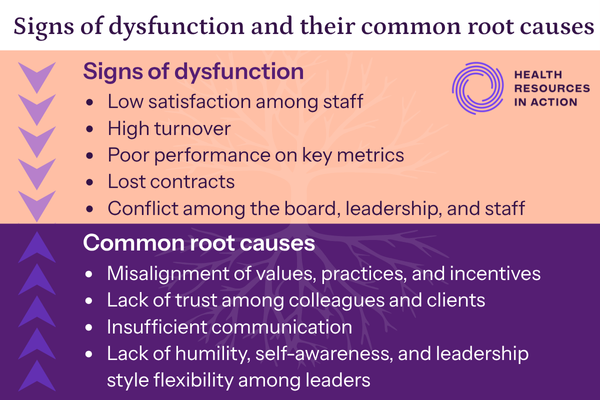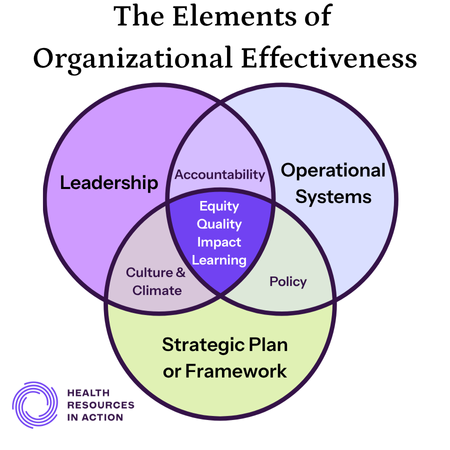“The greatest leader is not necessarily the one who does the greatest things; s/he is the one that gets the people to do the greatest things.” Daniel Goleman
Leaders shape organizational culture. Fostering a positive, engaging, and high-performing environment requires a solid foundation in core leadership competencies. While some leaders possess these naturally, most develop them through intentional learning and practice. Key competencies include:
- Embracing emotional intelligence,
- Adapting leadership styles,
- Nurturing partnerships, and
- Collaboratively creating and pursuing a shared vision.
At times, leaders and their teams can be successful despite developmental needs in these areas. Yet this type of success is often short-lived, as less skilled leadership can lead to conditions that hinder organizational effectiveness.
Organizational dysfunction: signs and solutions
High staff turnover, lost contracts, and poor performance are common signs of dysfunction across the nonprofit sector. These issues often stem from similar root causes, whether in philanthropic foundations or academic centers. Figure 1 outlines these common dysfunctions and their origins.
Figure 1: Signs of Dysfunctions and their Common Root Causes

After identifying these symptoms, the next step is to uncover their root causes and apply proven solutions. Turning things around requires purposeful, skilled, and steadfast leadership that focuses on recognizing and resolving these deeper issues. Competent leaders can energize an organization by uniting its people around common goals and improving its focus and adaptability, laying the groundwork for a resilient, high-performing organization. Let’s explore what it takes to get there.
The elements of organizational effectiveness
Efficient systems, engaged employees, strong performance metrics, and meaningful impact—these are the hallmarks of an effective organization. Achieving this level of effectiveness requires sound leadership, operational excellence, and a well-defined strategic plan. When these three elements are aligned—as shown in Figure 2, Elements of Organizational Effectiveness—organizations can improve quality, amplify impact, and advance equity. This alignment cultivates a culture of continuous learning, positioning organizations to more effectively achieve their mission and drive enduring, sustainable change. We use the following definitions for the three areas:
Figure 2: Elements of Organizational Effectiveness

- Leadership encompasses the skills, behaviors, and styles of those responsible for steering the organization.
- Operational systems refer to organizational processes and structures.
- A Strategic Plan/Framework (herein Strategic Plan) states the organization’s values, vision, mission, and goals, and its path to fulfill them.
To stay aligned, these three elements must reinforce each other. This happens in the areas of overlap among the elements. Table 1 describes what these areas of overlap look like when aligned (effective) and unaligned (ineffective).
Table 1: Areas of overlap, aligned and unaligned
| Area of overlap | Aligned | Unaligned |
|---|---|---|
| Accountability (Systems + Leadership) | Systems reinforce and reward what Leadership desires. Systems of accountability are clear and understood. | Systems reward actions contrary to what Leadership wants; unclear and ineffective systems of accountability. |
| Culture and Climate (Leadership + Strategic Plan) | Leadership directives align with the priorities and values laid out in the Strategic Plan. | Directives are incompatible with the priorities and values stated in the Strategic Plan. |
| Policy (Strategic Plan + Systems) | Systems facilitate policy adherence and drive toward goals stated in the Strategic Plan. | Policies and systems disincentivize the values or goals stated in the Strategic Plan. |
Having explored the core elements of organizational effectiveness, we now turn to a critical question: what happens when those elements fall out of sync? Identifying misalignment among leadership, operations, and strategy is not a reflection of failure. It signals awareness and readiness for meaningful change. With this clarity, organizations can take intentional steps toward transformation. The journey begins by assessing what work is needed and where to focus first.
Beginning an organizational transformation
As organizational dysfunction becomes apparent, leaders often seek specialized support to confront these complex challenges. This support may include leadership training, coaching, technical assistance, and more. However, some organizations rush into strategic planning, hoping it will resolve deeper issues. While strategic planning is a valuable tool, it rarely addresses underlying causes on its own. Fortunately, many organizations turn to HRiA, a trusted provider of strategic planning and organizational transformation services with decades of experience across the nonprofit sector.
Organizations that engage with HRiA begin with a brief discovery call to uncover their true needs. Through targeted questions, our team explores the organization’s identity, current circumstances, and definition of success. Some of the prompts offered by our team are:
- What result or outcome is the team looking for?
- Describe what a successful engagement would look like.
- What problem is the leadership team facing? How has it presented itself?
Based on the responses, HRiA determines how best to apply our capabilities to an organization’s needs through a customized approach. With expertise that covers a broad spectrum of organizational development and strategic planning services, our teams seek to co-create effectiveness across leadership, organizational systems, and a strategic plan.
How mission-driven organizations achieve effectiveness
Below are a few examples of how HRiA helped leaders across sectors transform their organizations.
An academic research center’s Executive Director (ED) sought assistance to ensure the center would thrive after his retirement. Over four years, HRiA provided strategic planning, action planning, and coaching for senior leaders. These activities led to the creation of a new, cross-functional senior leadership team and the center’s rebranding. The center evolved from siloed service providers (“Cores”) to matrixed Areas of Research Concentration. With this new direction, the Center obtained sustainable funding and thrived under the ED’s successor.
A new residency director at a medical center struggled to manage intense interpersonal conflict within his team. Through a half-day retreat, HRiA identified the need for greater clarity of expectations and a better-defined decision-making process. After the retreat, HRiA supported the director with communications and relationship management coaching. Through improved communication and role changes, the director improved the morale and efficacy of his team.
After an interstate move, a newly appointed director realized she had inherited an antiquated and dysfunctional county-wide health department. HRiA helped her navigate department restructuring while supporting her understanding of the state’s culture. HRiA also provided support and guidance as she built and developed a leadership team, formed an advisory group, and achieved departmental accreditation.
Organizational change requires the proper partner
Depending on the scope, organizational change can take anywhere from a few months to more than five years. Selecting the right partner is crucial to avoiding potential missteps and creating a clear path to success. HRiA has decades of experience collaborating with individuals, organizations, and coalitions. Through trusted partnerships, our teams help leaders and organizations build and strengthen the knowledge, skills, abilities, and tools they need to thrive in a fast-changing environment. If your organization is ready to move from dysfunction to effectiveness, our experts are ready to help.
Connect with us.
We work closely with our clients to tailor their project plan to meet their unique organizational needs. Even if you needs look a little different, we’d love to hear from you.
